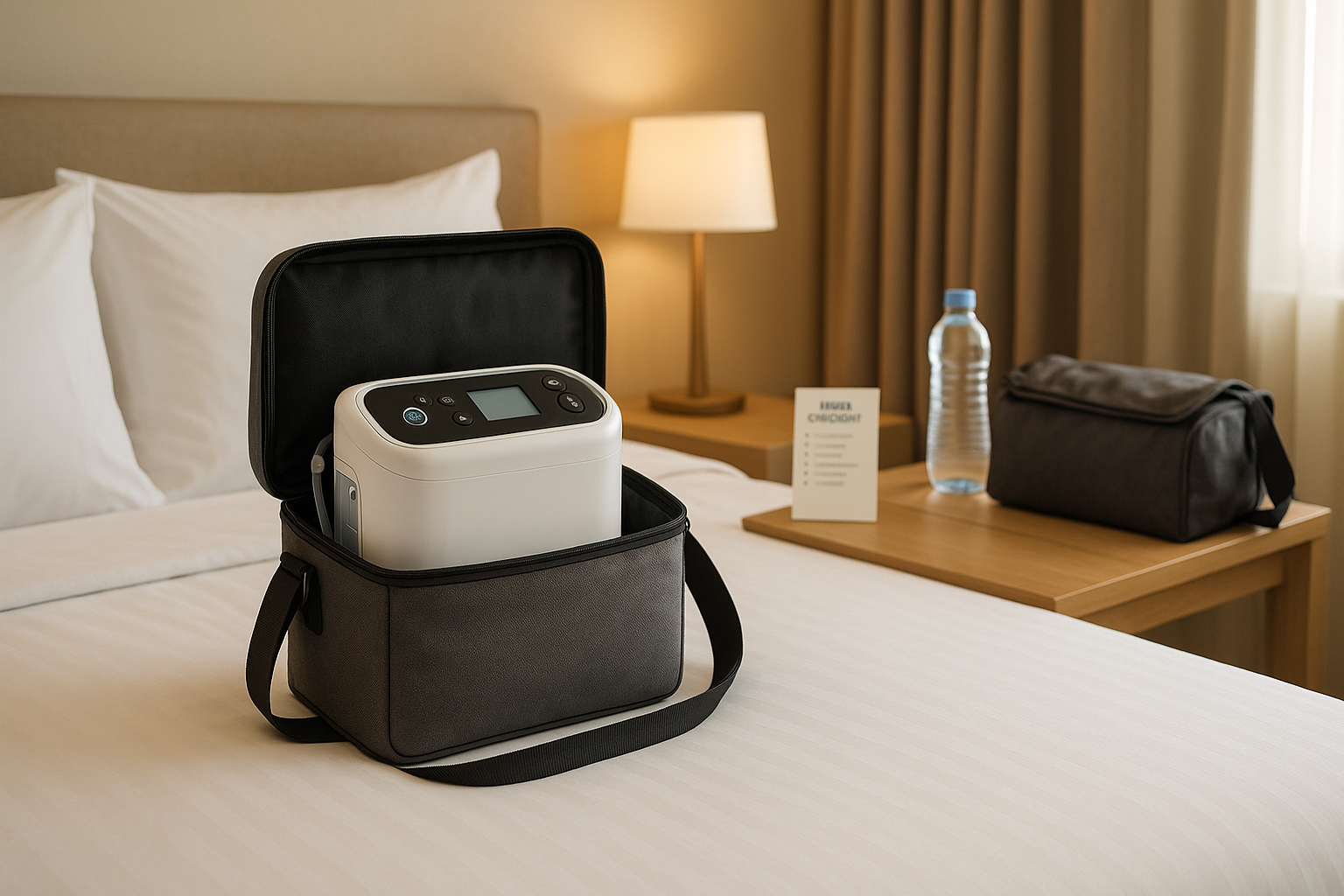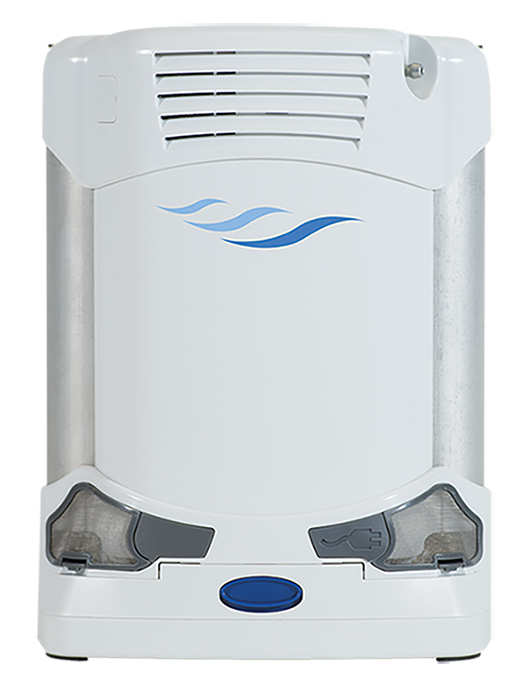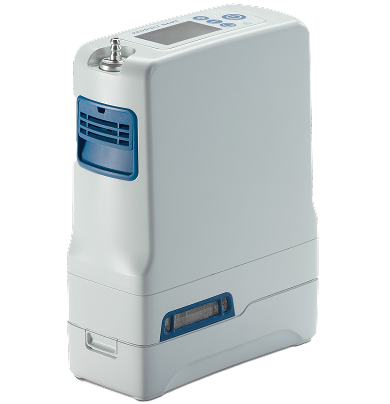Traveling with a portable oxygen concentrator (POC) can be challenging, but proper planning makes it manageable. Here's everything you need to know to ensure a smooth hotel stay while maintaining your oxygen therapy:
- Call Ahead: Inform the hotel about your oxygen needs, request convenient room placement, and confirm access to reliable power outlets.
- Pack Essentials: Bring your POC, extra batteries, chargers, tubing, and medical documentation. Include a power strip and backup supplies for emergencies.
- Set Up Safely: Position your POC for proper airflow, avoid heat sources, and test power outlets upon arrival. Use wall power when possible to preserve battery life.
- Prepare for Emergencies: Plan for power outages with backup batteries, portable oxygen tanks, and emergency contacts.
- Stay Comfortable: Manage tubing to avoid tripping hazards, reduce noise levels, and use a humidifier attachment if needed.
Quick Tip: Always keep your equipment clean, store it safely, and follow manufacturer guidelines to ensure optimal performance. By planning ahead and staying organized, you can enjoy a safe and comfortable hotel stay with your POC.
Traveling with a Portable Oxygen Concentrator
Planning Before Your Hotel Stay
When it comes to oxygen therapy, a little preparation can go a long way in ensuring a smooth and hassle-free hotel stay. Taking the time to plan ahead can help you avoid interruptions and keep everything running smoothly.
Call the Hotel Ahead of Time
Before your trip, reach out to the hotel to let them know you'll be bringing oxygen equipment that requires continuous power. This gives them plenty of time to accommodate your needs. During the call, ask about their backup power systems - do they have generators or other measures in place in case of a power outage? This is especially important if you rely on oxygen therapy.
Request a room near the elevators for easier access, and confirm that the room has convenient power outlets. If you have specific needs, like unscented or smoke-free accommodations, mention those as well. It’s also a good idea to discuss any safety concerns related to oxygen use. A quick follow-up call a few days before your arrival can ensure everything is set up as requested.
Pack Required Equipment
Make a checklist of all the essentials to keep your oxygen therapy uninterrupted. Start with your portable oxygen concentrator, spare batteries, and chargers. It’s smart to pack at least two extra batteries, as usage and settings can affect their lifespan. A backup charger is also handy for times when you’re away from your room.
Don’t forget to include copies of your oxygen prescription and any other medical documentation. These may be needed by hotel staff or emergency responders to verify your requirements. A carrying case or cart specially designed for medical equipment can make transport easier and protect your concentrator during travel.
Pack Extra Supplies
Having extra supplies on hand can make your stay more comfortable. Bring additional tubing and cannulas in case your primary ones get damaged or misplaced. These items are lightweight but crucial for effective oxygen delivery.
A power strip or extension cord can be a lifesaver if outlets are limited or hard to reach. If nasal dryness is an issue, consider packing a humidifier bottle to help with the transition to the hotel’s environment, which might have different humidity levels.
For longer stays or in areas where power might be unreliable, a backup power source can provide added peace of mind. Even if your trip is short, having this extra layer of security can be reassuring.
Lastly, make sure all your equipment is securely packed for travel. Store liquid oxygen upright and secure oxygen cylinders to prevent damage. Careful packing not only protects your equipment but also ensures it’s ready to use when you arrive.
Once you’ve done all the prep work, setting up your oxygen equipment in your hotel room will be quick and easy.
Setting Up Your POC in the Hotel Room
When you arrive at your hotel, take a few minutes to set up your portable oxygen concentrator (POC) properly. A quick and careful setup ensures your device runs smoothly throughout your stay.
Find Power Outlets
Start by locating reliable outlets near your bed or seating area. Test these outlets right away to confirm they provide steady power.
Be cautious of motion sensor systems that control power to outlets. Some hotels use these systems to conserve energy, but they can cut power to your device when no movement is detected - especially while you're sleeping. If you notice this happening, contact the front desk immediately to request an override for continuous power.
If the hotel uses key card–activated power systems, ask for an extra key card to keep the outlets active while you're out of the room.
For international travelers, double-check the voltage compatibility of the outlets. Even on American cruise lines, some outlets may operate on 220 VAC instead of the standard 110V. Packing a power adapter in your travel kit can save you from unexpected compatibility issues.
Once you've confirmed reliable power, you can position your device correctly.
Follow Device Instructions
Set up your POC according to the manufacturer's guidelines. Place the concentrator 1–2 feet away from walls, furniture, and other objects to allow for proper air circulation.
In December 2024, wikiHow released an updated guide on using oxygen concentrators, co-authored by Arvind Madan, an Internal Medicine Doctor. The guide emphasizes keeping the device 1–2 feet from walls and furniture to ensure good airflow and reduce fire risks. It has been viewed over 114,777 times, highlighting its usefulness for users.[3]
Avoid placing the device near heat sources such as radiators, heating vents, or windows with direct sunlight. Take a moment to check for any potential heat sources before finalizing the placement.
Do not use extension cords unless absolutely necessary, as they can pose fire risks when used with medical equipment. If an extension cord is unavoidable, ensure it meets the power requirements of your concentrator. It’s also a good idea to carry a voltage stabilizer, especially if you're staying in a hotel with older electrical systems, to protect your device from power surges.
Set the oxygen flow rate according to your prescription and the device manual. If you use a humidifier attachment, now is the time to connect it. Double-check all connections before powering on the device.
Store Backup Batteries Properly
Backup batteries are essential, but they require proper care to remain functional. Store them in a cool, dry place away from heat sources, direct sunlight, and high humidity.
Keep spare batteries at about a 50% charge to extend their lifespan. Batteries stored at this charge level are less likely to deteriorate and will be ready when needed. Avoid letting batteries drain completely and sit unused, as this can damage their long-term performance.
Choose a storage spot that is accessible and maintains a stable temperature, like a bedside table or a drawer. Avoid areas near air conditioning units or heating sources, as extreme temperatures - hot or cold - can harm the batteries and reduce their ability to hold a charge.
Make it a habit to check your battery levels each morning and evening, just as you would at home. This ensures you're always prepared, no matter what the day brings.
Maintaining Continuous Oxygen Supply
Once your portable oxygen concentrator is set up, keeping it running smoothly is essential. This involves using all available charging options, preparing for emergencies, and having backup oxygen sources ready. Here’s how to ensure uninterrupted oxygen supply.
Use All Charging Options
To keep your concentrator powered, take advantage of all charging methods: AC, DC, and internal batteries. Most devices support these options, but performance can vary. For instance, DC charging might not work as efficiently as AC, so it’s wise to test your device’s DC capabilities before traveling[4].
When you're in your hotel room, plug the device into a wall outlet as much as possible. This not only ensures continuous operation but also preserves battery life for when you're away from a power source. Many concentrators can run indefinitely when connected to an AC outlet.
For outings, bring along your car charger if you’re renting a vehicle or traveling with others. This allows you to recharge batteries during drives to restaurants, attractions, or medical appointments.
Plan for Emergencies
Emergencies can happen, so it’s important to be prepared. Keep your cell phone fully charged to contact emergency services, hotel staff, or your oxygen supplier if needed[5]. Discuss with your supplier how many extra batteries you’ll need for your trip[5].
Inform the hotel staff about your oxygen needs at check-in[5]. This ensures they’re aware and can assist promptly in case of power outages or emergencies[5].
Additionally, locate the nearest hospital or urgent care facility to your hotel. Keep their information, along with your doctor’s contact details and oxygen prescription, easily accessible. During power outages, limit physical activity to conserve oxygen and reduce your body’s demand[5].
Bring Backup Oxygen Sources
Battery life varies between concentrator models and flow settings, so having backup batteries is critical. Depending on your unit and prescribed flow rate, extra batteries can provide an additional 2 to 5 hours of use[6]. For example, the Wellue Portable Oxygen Concentrator offers up to 9 hours of operation on its lowest setting with a double battery pack, while a single battery lasts up to 4.5 hours[7]. Higher flow settings will reduce these durations. Here’s a breakdown of battery performance:
| Flow Setting | Single Battery Duration | Double Battery Duration |
|---|---|---|
| 1 | 4.5 hours | 9 hours |
| 2 | 3.5 hours | 7 hours |
| 3 | 2.5 hours | 5 hours |
| 4 | 2.0 hours | 4 hours |
| 5 | 1.5 hours | 3 hours |
For extended outings, consider carrying portable oxygen tanks. While heavier, they provide an independent supply that doesn’t rely on your concentrator’s functionality[7].
Replacement batteries can be costly, ranging from $200 to $618, so plan your budget accordingly[6].
sbb-itb-3e96dba
Safety and Comfort Tips
Once your equipment is set up and your oxygen supply is ready, it's time to focus on making your hotel stay as safe and comfortable as possible. Using a portable oxygen concentrator in a hotel room requires careful attention to its placement, noise levels, and additional equipment setup. These steps help ensure a smooth and restful experience.
Avoid Tripping Hazards
Oxygen tubing can easily become a tripping hazard, especially in the tighter, unfamiliar layouts of hotel rooms. To reduce risks, always be mindful of where the tubing is. Place the concentrator on a stable, central surface to keep the tubing out of high-traffic areas. This setup minimizes the need for long tubing stretches that could obstruct pathways. Also, double-check that the tubing isn't tangled around furniture legs or forming loops on the floor, as these can increase the likelihood of accidents[8].
Manage Noise Levels
Oxygen concentrators typically generate about 45 decibels of noise, mainly from their compressor and internal fans[10]. To keep the noise manageable, position the device on a stable, carpeted surface and consider using vibration-dampening pads. Soft furnishings in the room can also help absorb sound. Regular maintenance, such as cleaning filters, can further reduce operational noise[9]. If the sound persists, consider creating a white noise environment with a fan or the room’s air conditioner to mask the mechanical hum[9].
Use a Humidifier Attachment
Adding a humidifier attachment to your concentrator can make oxygen therapy more comfortable by preventing dryness and irritation in your respiratory system. This is especially helpful in dry climates or when using higher oxygen flow rates[11]. To attach a humidifier, first turn off and unplug the concentrator. Secure the bottle to the oxygen outlet, fill it with distilled water to the marked level, and check for leaks. Regular cleaning with mild detergent and distilled water is essential to prevent mineral buildup and ensure proper functioning[11].
Device Care and Storage
Taking proper care of your oxygen concentrator and storing it correctly can help extend its lifespan and save you from expensive repairs down the line [12]. Here’s how to keep your device in top shape and store it safely.
Clean and Maintain Your Device
Regular cleaning is especially crucial in environments like hotels, where dust and unfamiliar air quality can accumulate. Start by wiping the exterior of the concentrator with a soft, damp cloth. Avoid using abrasive materials or harsh detergents, as these can damage the device's surface and impair ventilation [13].
The external filters should be cleaned weekly using mild soap and water. Let them air dry completely before reinstalling. In particularly dusty conditions, you may need to clean them more frequently [12][13].
For your cannula or mask, use alcohol-free sanitizing wipes, paying close attention to the nasal prongs where bacteria can build up. Replace the cannula as advised by your physician or equipment provider [12][13].
Inspect power cords and batteries regularly for any signs of damage. If you notice any issues, stop using the device immediately and contact your equipment provider for assistance [13].
If your concentrator includes a humidifier bottle, clean it with mild soap, then disinfect it with vinegar. Allow it to air dry thoroughly and replace the bottle every six months to ensure hygiene and functionality [12][13].
Once your device is clean, proper storage becomes the next priority.
Store Equipment Safely
Storing your oxygen concentrator correctly is just as important as using it properly. Always keep the unit upright to protect its internal components. Place it on a stable, flat surface, or elevate it on a shelf or stand when not in use. If a shelf isn’t available, you can place it on the floor, but make sure it’s off carpet or on a protective barrier that won’t block ventilation ports [15].
Ensure the concentrator has at least 3 inches of clearance around it to allow for adequate airflow. Avoid storing it in poorly ventilated areas like hotel closets, as this can restrict airflow and negatively impact performance [15][17].
Proper storage also helps prevent accidents. Dropping the device can cause damage and may void the warranty, so always ensure it’s securely placed [14]. Keep your batteries in a cool, dry, and dark place, and make sure they’re fully charged before storing them [16].
Handle Long-Stay Storage Needs
If you’re staying in a hotel for an extended period, you might need to take additional steps to store extra oxygen supplies or backup equipment. Reach out to hotel staff to discuss safe storage options for oxygen tanks or other supplies you don’t need to access daily [1].
Always store oxygen cylinders upright and secure them to prevent tipping or rolling. Avoid cramped, poorly ventilated spaces like closets, cabinets, or under beds, as these can pose safety risks [18].
If you’re not using your concentrator frequently during your stay, run it for at least 10 hours each month to keep the sieve beds active and ensure it continues to perform well [16]. When not in use, store the device in its protective carrying case to minimize dust buildup and prevent accidental damage [16].
Finally, keep flammable materials away from both the concentrator and its storage area. Maintaining proper airflow around the device also helps prevent overheating and ensures consistent oxygen purity [17].
Key Points to Remember
Here’s a quick recap of the strategies for using your portable oxygen concentrator during a hotel stay:
When planning your trip, preparation is key. Call the hotel ahead of time to let them know about your equipment and ask about backup power options, as recommended by your healthcare provider [1]. This ensures you’re ready for any unexpected situations.
Before traveling, consult your doctor to gather any necessary medical documents and advice. It’s also a good idea to research your destination’s climate, air quality, humidity, and altitude, as these factors can impact your oxygen needs [1]. Stock up on enough oxygen supplies and medications to cover your entire trip, plus a little extra for emergencies.
Pack wisely by including essential extras like spare batteries, additional nasal cannulae, humidifier bottles, and any other important accessories. If you have sensitivities, notify the hotel staff in advance [1].
Safety should always be a top priority. Keep your concentrator at least 6 feet away from open flames, avoid smoking in its vicinity, and steer clear of aerosol products [14]. Placing "Oxygen in Use" signs in visible spots can help alert others to your equipment [20].
Make sure to use wall power whenever possible and charge your batteries regularly to maintain a steady oxygen supply [19]. If needed, coordinate with your oxygen supply company to deliver backup canisters to your hotel. Store any backup oxygen tanks upright in a well-ventilated area [1][20].
Routine maintenance is another important step. Check your oxygen tubing for cracks or leaks, clean nasal prongs to keep them clear, and wipe down the concentrator’s exterior with a soft, damp cloth [20]. Since hotels typically don’t provide medical oxygen, bring all the supplies you’ll need [2].
FAQs
If the power outlets in your hotel room are controlled by motion sensors or key card systems, don’t worry - there are ways to keep your portable oxygen concentrator running smoothly:
- Reach out to the front desk: Let them know about your situation. They might offer solutions like access to a continuous power outlet or another option to keep your device powered.
- Pack a portable power bank: A high-capacity power bank can serve as a reliable backup during power interruptions.
- Ask for a different room: Some rooms may not have outlets linked to these systems. It’s worth checking if a room change could resolve the issue.
By planning ahead and communicating your needs with the hotel staff, you can ensure your oxygen concentrator stays powered throughout your stay.
To use your portable oxygen concentrator (POC) safely in a hotel room, start by informing the hotel staff about your requirements. This helps ensure you’re accommodated in a well-ventilated, non-smoking room. Place your POC on a sturdy surface, keeping it away from heat sources, open flames, and moisture. Make sure the device’s ventilation openings remain unblocked. Smoking or allowing smoking near the device is strictly prohibited.
Ensure your POC is fully charged or connected to a dependable power source. It’s a good idea to bring backup batteries or additional charging options to prevent any interruptions. If the device’s noise is bothersome, consider using a noise-reducing case for added comfort. Taking these steps will help you stay prepared and enjoy a smooth, stress-free stay while meeting your oxygen needs.
To ensure you're ready for potential power outages, make sure to charge spare batteries for your portable oxygen concentrator and, if possible, bring backup oxygen tanks. Inform the hotel staff about your medical requirements so they can provide assistance during emergencies. It’s also a good idea to carry a portable power source, like a small generator or power bank, to keep your oxygen supply running smoothly. For extra peace of mind, you might want to move to an area of the hotel equipped with backup power systems.






